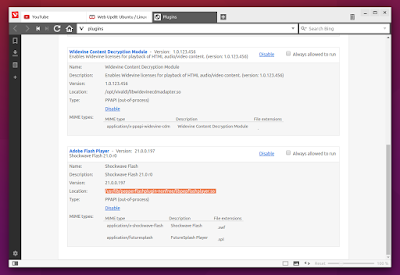Vivaldi 1.0 stable was released today and if you gave it a try, you might have noticed, at least on a fresh Ubuntu installation, that Flash and H.264 don't work out of the box.
Here's how to get Adobe Flash and H.264 (used, for instance, by the YouTube HTML5 player) to work with Vivaldi browser, in Ubuntu, Linux Mint and derivatives.
Get Vivaldi browser to support H.264
 |
| Before installing "chromium-codecs-ffmpeg-extra" |
 |
| After installing "chromium-codecs-ffmpeg-extra" |
To enable H.264 support for Vivaldi in Ubuntu, you need to install a package called "chromium-codecs-ffmpeg-extra".
This is already available if Chromium browser is installed on your system. If you don't have Chromium browser, you can install the package that provides H.264 support by using the following command:
sudo apt-get install chromium-codecs-ffmpeg-extraAnd restart Vivaldi.
You can check if your browser supports H.264 by visiting the YouTube HTML5 page.
Get Adobe Flash working in Vivaldi Browser
This part of the article was updated since Google Chrome no longer ships with Pepper Flash.
To get Flash working in Vivaldi, you must install the adobe-flashplugin package, available in the Canonical Partner repository:
1. Enable the Canonical Partner repository
To do this, open Software & Updates, and on the "Other Software" tab, enable "Canonical Partners". Then click "Close", and when asked to reload the software sources, click the "Reload" button.
2. Install adobe-flashplugin:
sudo apt-get install adobe-flashpluginExtra tip:
If Google Chrome is installed, Vivaldi will automatically pick up its Widevine Content Decryption plugin (it comes with a symbolic link to the location of the libwidevinecdm.so plugin in the Google Chrome stable installation folder).
If you don't want to install Google Chrome and you need this plugin, you can extract libwidevinecdm.so from the Google Chrome deb and place it in /opt/vivaldi/, replacing the existing symbolic link.
thanks to B.Jay for the tip!


